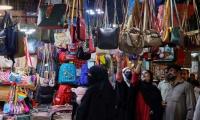PESHAWAR: Provincial Minister for Planning and Development and Finance Taimur Saleem Jhagra said on Saturday that the government was keen to develop synergies in poverty alleviation and livelihood strategies in Khyber Pakhtunkhwa.
The minister visited the projects being implemented by the SRSP and community organisations in Nowshera district. He was also accompanied by MPA Ibrahim Khattak. The trip was organised by the Sarhad Rural Support Programme (SRSP). The visit was paid to some villages where the Livelihood Strengthening Programme (2010 -2014) and Women Empowerment and Market Development Programme (WEEMD) funded by AusAid had operated between 2015-2019. These projects had been developed as part of government policy to involve the third sector in the development process.
During the visit, the minister interacted with the communities and sought their feedback about the programmes and how they had impacted their lives. The minister said that the visit was part of the government’s commitment to make best use of the resources of the province and develop synergies between different development efforts in the province and also to improve the development process by learning from different experiences.
In the first programme, the SRSP officials said, community-led poverty scorecards were developed, social mobilisation and creation of community, village and local support organisation was undertaken. This was supported with community infrastructure and natural resource management activities. While in the second programme, Village Banks for Community Investment Funds and Micro Credit were established. The economic activities were boosted by development of different value chains based in communities and women business investment centres and adult and financial numeracy programmes were also integral to the programmes.
At Gujjar Mullago village in Jhagra, the minister was greeted by over 300 women who explained that a community Investment Bank (CIF) had been created with an initial seed money of Rs1 million by 18 women organisation in the area. The community bank in the last four years had disbursed Rs14.83 million of credit from the seed money to over 318 households. The community investment fund gave subsidized loans to the poorest segments of the population. The portion of the population, above the poverty line, were linked to micro credit lines which distributed Rs27 million to them covering 2,360 households. The community leaders explained the difference the programme made in their lives.
A women business centre was also set up as part of the bank, which has six master trainers giving training to the women as beautician, handmade embroidery, and fashion design training 75 individuals. Basic adult and financial literacy are also part of the training. The SRSP officials explained that the initial seed money of Rs46 million that had been invested in communities under the programme had been circulated to the tune of over Rs400 million, benefitting Rs18,000 households in 72 banks. The minister was informed that this alternate model of credit was developed because micro-finance institutions were not willing to move into the more marginal regions of the province because of thin geographical spread of the population and high cost of delivery in the province.
Similarly, it was found that traditional micro finance did not serve the lower bracket in the poverty line. The CIF system was also empowering for the women because in this system the ownership of the seed money belonged to women groups and decision making was in their own hand and not that of a commercial bank. Later, the minister visited village Bara Banda where he met members of women groups that had specialized in five trades: beautician, crochet work, fashion designing, handmade embroidery and are embroidery.
In order to stimulate growth and promote livelihood different value chains have been developed like meat, milk, marigold flower in sectors in which women are already involved. The garland value chain demonstrated their production skills to the minister and also showed how 300 women had become involved in the activity in the community. The intensive social mobilization provided the women with a forum in which they were able to undertake all these activities in an area that was traditionally a conservative area. The village bank supported these women groups through provision of subsidized lending through the Community Investment Funds to the poorer segment of the population and a linkage to micro credit providers to those in the higher brackets of the poverty line.
Plea was filed by Amir Nawaz Warraich, President of Karachi Bar Association under Article 184 of Constitution
Tariq Fatemi says there is something fascinating about Pakistan-China ties that has puzzled scholars for years
Saudi Airlines to provide travel facilities for 35,000 Pakistani govt Hajj pilgrims to and from Saudi Arabia, says...
Atta says, "We reiterate our full support and confidence in the esteemed members of the JCP"
Noor Islam says that killers had also broken locks of cupboards and stolen two tolas of gold jewelry and Rs50,000 in...
PHC grants transit bail to MNA Shahram Tarakai and his brother and KP Minister Faisal Tarakai







